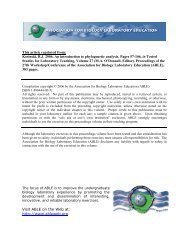Chapter 15 Variability and Selection in Natural Populations of Wood ...
Chapter 15 Variability and Selection in Natural Populations of Wood ...
Chapter 15 Variability and Selection in Natural Populations of Wood ...
You also want an ePaper? Increase the reach of your titles
YUMPU automatically turns print PDFs into web optimized ePapers that Google loves.
246 Isopod <strong>Variability</strong><br />
Contents<br />
Introduction.......................................................................................... 246<br />
Notes for the Instructor........................................................................ 246<br />
Student Outl<strong>in</strong>e .................................................................................... 247<br />
Materials .............................................................................................. 249<br />
Acknowledgments ............................................................................... 252<br />
Literature Cited.................................................................................... 252<br />
Appendix A: Materials........................................................................ 253<br />
Introduction<br />
Introductory students <strong>of</strong> evolutionary biology <strong>of</strong>ten focus on the consequences <strong>of</strong> natural<br />
selection without hav<strong>in</strong>g a solid grasp <strong>of</strong> the underly<strong>in</strong>g importance <strong>of</strong> character variability. By<br />
exam<strong>in</strong><strong>in</strong>g variation <strong>in</strong> a natural population <strong>of</strong> real organisms <strong>and</strong> subject<strong>in</strong>g them to artificial<br />
predation, students are able to explore the relationship between variation <strong>and</strong> selection.<br />
Our students perform this exercise <strong>in</strong> the <strong>in</strong>troductory laboratory course they take dur<strong>in</strong>g their<br />
second year. Variations on the experiment are also taught at local high schools (AP Biology) <strong>and</strong><br />
community colleges. The availability <strong>of</strong> wood lice <strong>and</strong> the simplicity <strong>of</strong> the materials make this<br />
exercise especially attractive.<br />
Notes for the Instructor<br />
We have chosen to do this exercise with wood lice because they are excellent experimental<br />
subjects <strong>and</strong> they are readily available <strong>in</strong> our area. Students collect their experimental animals, which<br />
provides an <strong>in</strong>troduction to the organism as well as to its habitat <strong>and</strong> behavior. In many regions, this<br />
would not be possible year-round <strong>and</strong> animals could be ma<strong>in</strong>ta<strong>in</strong>ed <strong>in</strong> the lab or ordered from a<br />
biological supplier. Alternatively, laboratory reared animals such as mealworms or guppies might be<br />
substituted.<br />
We do the exercise that follows <strong>in</strong> the manner described <strong>in</strong> the Student Outl<strong>in</strong>e <strong>in</strong> order to<br />
f<strong>in</strong>ish the entire experiment <strong>in</strong> one 3-hour laboratory period. However, pedagogically, the exercise<br />
makes more sense if students first measure several characters <strong>and</strong> then characterize the extent to<br />
which they vary. Based on their assumptions <strong>and</strong> knowledge <strong>of</strong> the biology <strong>of</strong> these organisms, the<br />
next step would be for students to construct one or more hypotheses about how predation might be a<br />
selective force on the traits exam<strong>in</strong>ed. Once predictions have been made, the artificial predation<br />
experiment would be performed. Follow<strong>in</strong>g predation, survivors <strong>and</strong> victims would be exam<strong>in</strong>ed to<br />
see if character variation <strong>in</strong> the two groups differed. When we conducted the parts <strong>of</strong> the exercise <strong>in</strong><br />
this more logical sequence, it took at least four hours to complete. Hence, we chose to reverse the<br />
order <strong>of</strong> activities, beg<strong>in</strong>n<strong>in</strong>g with perform<strong>in</strong>g artificial predation <strong>and</strong> then characteriz<strong>in</strong>g variation.<br />
All students are asked to measure body length, number <strong>of</strong> dorsal plates, <strong>and</strong> spr<strong>in</strong>t speed.<br />
These characters were chosen to represent a range <strong>of</strong> character types (e.g. physiological,<br />
morphological, <strong>and</strong> behavioral) as well as to demonstrate both variable <strong>and</strong> <strong>in</strong>variant characters.<br />
Other traits our students have chosen to measure <strong>in</strong>clude body width, mass, color, number <strong>of</strong> legs, etc.<br />
<strong>Variability</strong> <strong>in</strong> some <strong>of</strong> the traits exam<strong>in</strong>ed has a heritable component, while <strong>in</strong> others it may be strictly<br />
environmental <strong>and</strong>/or developmental. This is not dealt with explicitly <strong>in</strong> the exercise but may come<br />
up <strong>in</strong> discussion <strong>and</strong> is an important po<strong>in</strong>t.
















